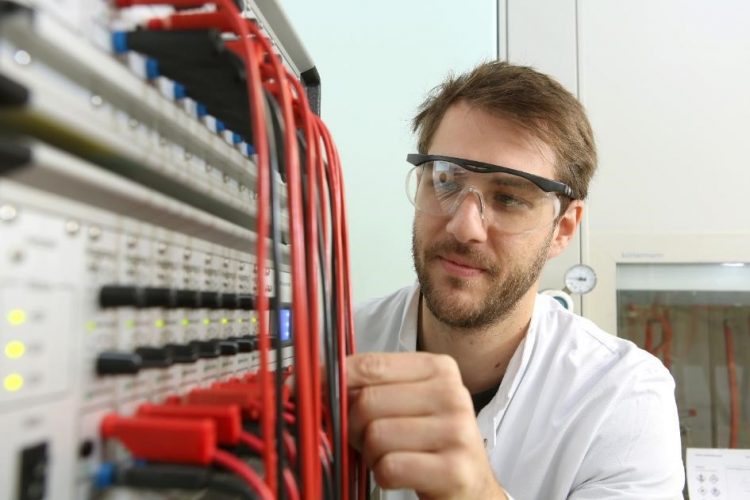Electrochemistry opens up novel access to important classes of substances

A young researcher in Professor Waldvogel's team using a screening apparatus for parallel electrolysis optimization photo/©: Alexander Sell
Electrochemistry has undergone a renaissance in recent years and numerous research groups are currently working on the environmentally friendly production or conversion of molecules. However, despite the superiority of electrochemistry, its application to various molecules has been problematic.
The electrolysis of highly reactive substances, for example, has so far only led to the formation of high-molecular weight products, i.e., polymers. This method of production was sometimes even used on purpose as in the examples of polythiophene and polyaniline, the latter also being known as aniline black.
Chemists at Johannes Gutenberg University Mainz (JGU) have now succeeded in overcoming the problem of electrochemical polymer formation and in developing a sustainable and efficient synthesis strategy for these important products for the first time.
In order to generate chemical reactions, electrochemistry uses electrical current instead of partly hazardous chemical reagents and thus without reagent waste. This environmentally-friendly method provides easy access to a number of compounds with high chemical, pharmaceutical, and material science potential, such as building blocks for co-catalysts in homogenous catalysis.
The research group led by Professor Siegfried Waldvogel from the Institute of Organic Chemistry at Mainz University have now developed a method to use this key technology with highly reactive substances. “Working with certain starting substances, electrochemistry always resulted in polymers. Now we can choose to bring together only two building blocks”, explained Waldvogel. This strategy was developed in collaboration with Evonik Performance Materials GmbH.
However, it is not only the simplicity of this synthesis that is convincing, but also its environmental friendliness. The only “waste” produced is hydrogen, which is known as an environmentally friendly fuel. The key to success here is the use of a unique electrolyte system, which is extremely stable and can be reused after electrolysis, reinforcing the green aspect of this method. In addition, this extraordinary electrolyte is also the source of the high selectivity of these reactions. Therefore, a very simple electrolysis setup can be used.
In other words, the scientists succeeded for the first time in carrying out an electrochemical carbon-carbon cross-coupling of thiophenes with phenols. In another experiment, the oxidative cross-coupling of aniline derivatives was carried out, producing selectively a broad spectrum of biphenyl diamines. The papers were published in the journal Angewandte Chemie.
Publications:
Anton Wiebe et al.
Einfache und doppelte metall- und reagensfreie anodische C-C-Kreuzkupplung von Phenolen mit Thiophenen
Angewandte Chemie, 20 October 2017
DOI: 10.1002/ange.201708946
http://onlinelibrary.wiley.com/doi/10.1002/ange.201708946/abstract
Lara Schulz et al.
Reagens- und metallfreie anodische C-C-Kreuzkupplung von Anilinderivaten
Angewandte Chemie, 2 March 2017
DOI: 10.1002/ange.201612613
http://onlinelibrary.wiley.com/doi/10.1002/ange.201612613/abstract
Photos:
http://www.uni-mainz.de/bilder_presse/09_orgchemie_elektrochemie_kupplung_01.jpg
A young researcher in Professor Waldvogel's team using a screening apparatus for parallel electrolysis optimization
photo/©: Alexander Sell
http://www.uni-mainz.de/bilder_presse/09_orgchemie_elektrochemie_kupplung_02.jpg
A young researcher in Professor Waldvogel's team working with the electrolysis equipment
photo/©: Alexander Sell
Contact:
Professor Dr. Siegfried R. Waldvogel
Institute of Organic Chemistry
Johannes Gutenberg University Mainz
55099 Mainz, GERMANY
phone +49 6131 39-26069
fax +49 6131 39-26777
e-mail: waldvogel@uni-mainz.de
http://www.chemie.uni-mainz.de/OC/AK-Waldvogel/
http://www.uni-mainz.de/presse/aktuell/2784_ENG_HTML.php – press release “Scientists develop electro-organic synthesis that allows sustainable and green production of fine chemicals” (Oct. 9, 2017) ;
http://www.uni-mainz.de/presse/aktuell/1532_ENG_HTML.php – press release “Waste from paper and pulp industry supplies raw material for the development of new redox flow batteries” (May 11, 2017)
Media Contact
All latest news from the category: Life Sciences and Chemistry
Articles and reports from the Life Sciences and chemistry area deal with applied and basic research into modern biology, chemistry and human medicine.
Valuable information can be found on a range of life sciences fields including bacteriology, biochemistry, bionics, bioinformatics, biophysics, biotechnology, genetics, geobotany, human biology, marine biology, microbiology, molecular biology, cellular biology, zoology, bioinorganic chemistry, microchemistry and environmental chemistry.
Newest articles

First-of-its-kind study uses remote sensing to monitor plastic debris in rivers and lakes
Remote sensing creates a cost-effective solution to monitoring plastic pollution. A first-of-its-kind study from researchers at the University of Minnesota Twin Cities shows how remote sensing can help monitor and…

Laser-based artificial neuron mimics nerve cell functions at lightning speed
With a processing speed a billion times faster than nature, chip-based laser neuron could help advance AI tasks such as pattern recognition and sequence prediction. Researchers have developed a laser-based…

Optimising the processing of plastic waste
Just one look in the yellow bin reveals a colourful jumble of different types of plastic. However, the purer and more uniform plastic waste is, the easier it is to…



